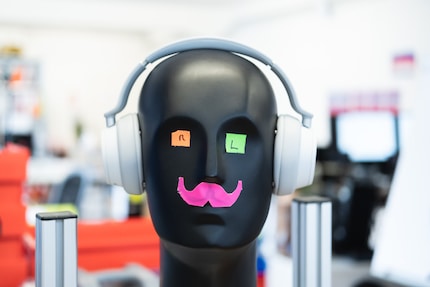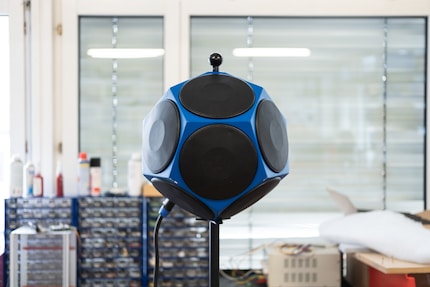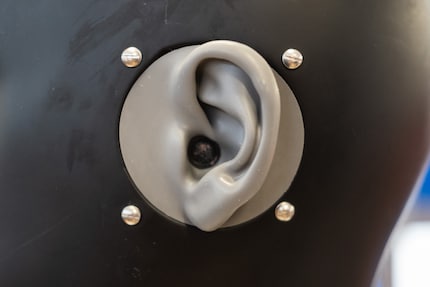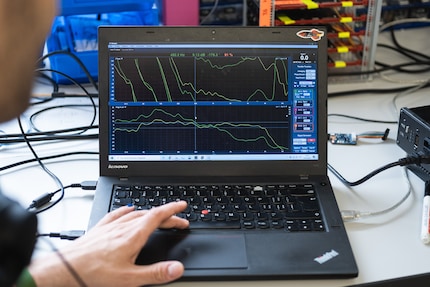
Background information
Rocket Science - the company that immobilises a fireplace
by Livia Gamper

Rocket Science tests seven ANC headphones. How and with what kind of setup do the noise professionals measure the noise cancelling of headphones?
Pragmatic. This is how Philippe Niquille, CEO of Rocket Science, describes the test procedure. He and his team are scrutinising ANC headphones for my article. We want to find out which headphones have the most effective noise cancelling, i.e. which can best eliminate background noise. I am amazed when I realise that the headphones are simply measured in the office. Now I realise that it's much less about the measurement itself than the evaluation of the measurements.
You can find out who Rocket Science is and why the company tests headphones for us in the article below.
For the comparison of seven ANC headphones, Rocket Science set up a small but effective test scenario at its office in Zurich's Binz neighbourhood. The four noise experts Nele, Philippe, Nino and Manu want to find out how well the headphones make outside noise disappear.
Philippe and his team put the headphones on a plastic head. The head, called "the Noise Chancellor" by the team, has two microphones built into its "ears". Christian Frick, CTO of Rocket Science, bought the plastic head from a couple of bird friends. They needed it to record bird noises as realistically as possible. Rocket Science uses the Noise Chancellor in almost the same way: It measures the noise frequencies played by the team with its microphone ears in a similar way to a human.
The position of the noise signal excitation always remains the same for reproducibility.

But what kind of noise is suitable for consistently measuring headphones? The team at Rocket Science opted for pink noise, also known as pink noise. With this noise, the volume decreases with increasing frequency. With pink noise, the low tones therefore dominate, which is roughly the case in a natural environment. Many everyday signals, such as train wheels, are similar to pink noise.
Rocket Science plays the noise signal with a dodecahedron loudspeaker and a modified Fostex subwoofer.

With the two-way system of the dodecahedron loudspeaker and the Fostex subwoofer, the acoustic professionals create what is known as a diffuse field. In a diffuse field, the sound comes from all directions. This is important. For example, if you are sitting on a train, you are also in a sound field whose noise sources are in different places; the rattling of the train comes from almost all sides. The noise is emitted from the walls and windows of the train carriage. In contrast to tests in an anechoic chamber, i.e. a soundproof room, the professionals at Rocket Science can therefore carry out their measurements in a realistic yet reproducible environment. In other words, unlike a test in a sealed chamber with an artificial diffuse field, the professionals can take realistic measurements with a real diffuse field.
Sound that only comes from one direction directly from a sound source is called direct sound. Direct sound is usually accompanied by single and multiple reflections. In rooms, direct sound only plays a subordinate role for greater distances to the sound source.

Any number of things can be measured. What is important is the interpretation of the results and what conclusions are drawn from them. The measurement chain must be consistent. This is why it is also possible to measure the noise cancelling of headphones in the office.
The team uses the measurement software Smaart to interpret the results. This measures the signals, i.e. the noise emitted by the loudspeakers, and compares them with the frequencies that are relevant for the measurement. The team analyses the frequencies from 50 Hz to 2,000 Hz. Active noise cancelling works in this range.
The software used ensures that the measurement only analyses the signals sent by the loudspeaker. This means that the measurement is not disturbed if someone in the office is talking during the measurement.

To understand the measurements, or rather the measurement results from Rocket Science, you need to know how noise cancelling works. Noise cancellation can be roughly divided into two categories: passive and active. Passive noise cancellation attenuates sound waves. This happens when you simply switch off the headphones and put them on your head. The passive part is mainly limited to high frequencies and the effectiveness depends on many factors, such as the material of the ear cup. The attenuation loses its effect if the headphones do not fit well and do not completely enclose the ears.
Active noise cancelling describes the cancellation of noise by playing in anti-noise. Under certain conditions, the actively recorded anti-noise and the interference signal cancel each other out - thus reducing the noise. This process is also known as destructive interference. Microphones integrated into the headphones register the noise and in-built processors then calculate the necessary anti-noise signal. This works best at low frequencies.
Rocket Science wants to know which headphones have the most effective active noise cancelling. In order to exclude passive reduction, they measure this separately on the noise canceller and then subtract it during the evaluation. The audio professionals focussed on the technological, active part of noise cancelling, as this is decisive and more exciting.
You can find out which headphones actively reduce sound best in the article below.
Testing devices and gadgets is my thing. Some experiments lead to interesting insights, others to demolished phones. I’m hooked on series and can’t imagine life without Netflix. In summer, you’ll find me soaking up the sun by the lake or at a music festival.
Practical solutions for everyday problems with technology, household hacks and much more.
Show all